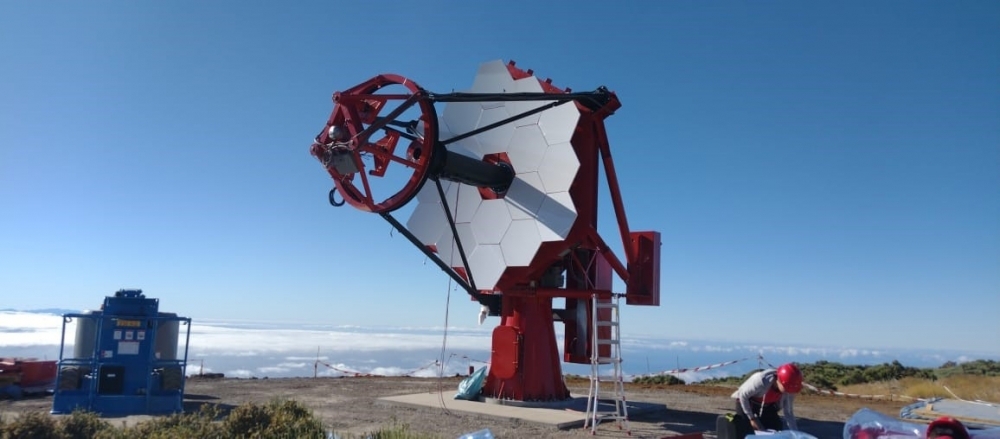


Astronomers from Brazil, Italy and South Africa have begun installing the first of nine telescopes sensitive to gamma rays on Tenerife in Spain’s Canary Islands (photo: Carlos Firmino)
Published on 08/23/2022
By Elton Alisson | Agência FAPESP – Astronomers from Brazil, Italy and South Africa have begun installing the first of nine Imaging Atmospheric Cherenkov telescopes at the Teide Observatory on Tenerife, in Spain’s Canary Islands. The telescopes will be capable of detecting very high-energy gamma rays, the most energetic form of electromagnetic radiation in the universe, with over 10,000 times more energy than visible light photons.
All nine telescopes in the array are scheduled for completion in mid-2023, and the first images should be available in 2024.
The Brazilian researchers have participated in all stages of construction of the first telescope, with support from FAPESP via a Thematic Project.
“Participation in this project is strategically important for Brazil, which will be able to develop its know-how in the production of instrumentation for multi-frequency astronomy,” Elisabete de Gouveia Dal Pino, principal investigator for the Thematic Project, told Agência FAPESP. Dal Pino is a professor at the University of São Paulo's Institute of Astronomy, Geophysics and Atmospheric Sciences (IAG-USP).
“Brazil has a track record in developing instrumentation for optical telescopes and radio telescopes. We're now starting to participate in gamma-ray astronomy. As a result, we’re covering all frequencies in the spectrum, from radio to gamma rays,” she said.
The Brazilian and Italian scientists have developed the first telescope in the ASTRI Mini-Array, a cluster of nine Cherenkov telescopes, each of which will have a diameter of 4 m and the same structure as the small-size telescopes (SSTs) that will make up the Cherenkov Telescope Array (CTA), the world’s largest gamma-ray observatory, in which Dal Pino and her group are also participating. The group is responsible for construction of three of the nine telescopes in the ASTRI Mini-Array.
With an estimated cost of 400 million euros and 31 participating countries, including Brazil, the CTA will be a network of some 100 Cherenkov telescopes capable of detecting and generating images of high-energy particle showers produced when gamma rays coming from outer space hit Earth’s atmosphere.
As gamma rays reach Earth, they collide with molecules in the air and produce cascades of secondary subatomic particles (electrons and positrons) known as air or particle showers. These ultrahigh-energy particles can travel faster than light in air, creating a blue flash similar to the sonic boom created by an aircraft exceeding the speed of sound.
The effect is known as “Cherenkov light” after Russian physicist Pavel Cherenkov (1904-1990), who discovered it experimentally (more at: agencia.fapesp.br/25605).
“The chance to look at the universe in this extreme portion of the spectrum has been made possible only recently thanks to the water tanks sensitive to Cherenkov light installed at the High Altitude Water Cherenkov Observatory [HAWC] in Mexico, and China’s Large High Altitude Air Shower Observatory [LHAASO]. But the signals captured by these means are low-resolution, and it’s impossible to be sure of their source,” Dal Pino said.
Higher resolution
According to Dal Pino, the CTA will increase the resolution of these sources by a factor of ten, thanks to its larger light-collecting area and the combination of three classes of Cherenkov telescopes with different sizes at two sites – the European Southern Observatory (ESO) at the top of Mount Paranal in Chile’s Atacama Desert, and the Roque de Los Muchachos Observatory in La Palma (Canary Islands), Spain.
On Paranal, the first stage of construction will see 14 medium-size telescopes in an area of some 3 km2, each with a diameter of 12 m, and 37 SSTs, each with a diameter of 4 m. This array will be used mainly to observe high-energy, very bright events in the Milky Way.
On La Palma, the first stage will involve an area of about 0.5 km2 containing four very large telescopes, each with a diameter of 23 m, and nine medium-size telescopes. This array will focus on less energetic, less bright events outside our galaxy.
The larger telescopes will be used to capture the phenomena that produce less energy and light, while the smaller telescopes will be used to observe phenomena that are highly energetic and very bright, with the medium-size telescopes focusing on the intermediate range of energy and luminosity.
In a project also supported by FAPESP, another group of Brazilian researchers led by Luiz Vitor de Souza Filho, a professor at the São Carlos Institute of Physics (IFSC-USP), has developed the camera mount for the medium-size telescopes.
“This configuration of telescopes with three different sizes will enable astronomers to observe gamma radiation in a wide energy range, between 20 gigaelectron-volts (GeV) and 300 teraelectron-volts (TeV),” Dal Pino explained.
Testing of the ASTRI Mini-Array is starting now, in collaboration with Italian and South African astronomers, and will be highly useful for the CTA. “The tests will let us make changes to correct any minor structural errors,” she said.
Construction of CTA South on Paranal (Chile) began before the COVID-19 pandemic. Work on CTA North on La Palma (Spain) was to have begun this year but has been delayed by the pandemic, the Cumbre Vieja volcanic eruption on the island in September 2021, and more recently the Russia-Ukraine war.
“Several events have affected the CTA’s timetable in recent years. The Russia-Ukraine war, for example, reduced steel supplies and drove up prices of this material. Most of the steel used in Europe is produced in Ukraine,” Dal Pino said.
Source: https://agencia.fapesp.br/39415